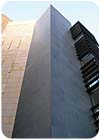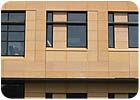
Photo by Phil Harding
The 50,000-square-foot Malone Engineering Center at Yale University in New Haven, CT, was recently designed with Bursting Stone slate from the U.K. and Minnesota travertine. The five-level building houses research labs, offices and classrooms, and caters to the departments of mechanical, biomedical and chemical engineering. The center was made possible due to the generous gift of John Malone, the chair of Liberty Media Corp. and a 1963 graduate of Yale's engineering program, who is known for his pioneering role in communications media.
When designing the building, Pelli Clarke Pelli Architects sought to combine aesthetics and functionality, and to make the most of the building's challenging site and position.
According to Architect Mariko Masuoka from Pelli Clarke Pelli Architects of New Haven, CT, the stones were selected to help blend the building with other facilities on campus. “We wanted the building to match the content of other buildings in the area,†she said.

Photo by Phil Harding
A palette of stone
Honed Olive Green Bursting Stone, which was quarried in England's Lake District by Burlington Slate Limited and supplied by Burlington Natstone of Plano, TX, was used to clad the east facing core wall, as well as the mechanical penthouse on the roof. According to Masuoka, the material was chosen because it matched the color scheme in place at the building. “The green went very well with the palette of colors we selected for the curtainwall,†she said.In addition, Minnesota travertine from Vetter Stone Co. of Kasota, MN, was used on several sides of the building in a sanded finish with a fleuri cut. The same material was also used in a bushammered finish on the relief portion of the building, and for the stone facing on the lower portion of the building.

Photo by Phil Harding
The front elevation features different layers of stone in the release. “We kind of exaggerated the release by using the travertine in a bushammered finished in one plane and the sanded finish in another,†said Masuoka, adding that the design creates shadows. “A lot of the older buildings on campus have a lot of release, and we did something that blends in pretty well.â€
The stone cladding was 1 ¼ inches in thickness, the cappings featured 5-inch and 1 ½ -inch thicknesses, and the paving was 1 ¼ inches thick.

Photo courtesy of Pelli Clarke Pelli Architects
Adjusting to the site
“The engineering lavatory building had to fit on a very small site of only 12,000 square feet,†explained the architect. “We had to create a very compact building. The site was triangular, and we had to optimize the site by placing the main corridor on the hypotenuse of the triangle.â€Along the hypotenuse is a former railway line, which was later converted to a bike path. “We wanted to tie the bike path into the building, so the site at the bike path level is about 20 feet lower than the main entrance level,†the architect said. “We inserted an entire lab floor along the bike path with a stone facing material on the lower portion of the building.â€
In addition to conforming the building to the dimensions of the site, the architects also faced some financial challenges. “As with any institutional project, you always have budget issues,†Masuoka explained. “We tried to create enough release and visual interest in the stone and still maintain the budget that we had.â€

Photo courtesy of Pelli Clarke Pelli Architects
Somers explained that the most difficult part of the installation involved the coordination of the window openings with the stone pattern. “We overcame this through detailed communication with the stone manufacturer and their engineering department,†he said.
Overall construction began in January 2003, and the project was completed in October 2005. According to Masuoka, the project has been well received, and the university is extremely happy with the end result.

Malone Engineering Center
Yale University
New Haven, CT
Architect:Pelli Clarke Pelli Architects, New Haven, CTGeneral Contractor: The Whiting-Turner Contracting Co., New Haven, CT
Stone Installer: NER Construction Management, Inc., West Haven, CT
Stone Quarriers: Burlington Slate Limited, Kirkby-in-Furness, Cumbria, England (slate); Vetter Stone Co., Kasota, MN (travertine)
Stone Supplier: Burlington Natstone Inc., Plano, TX (slate)
Installation Products: Custom Building Products, Seal Beach, CA


